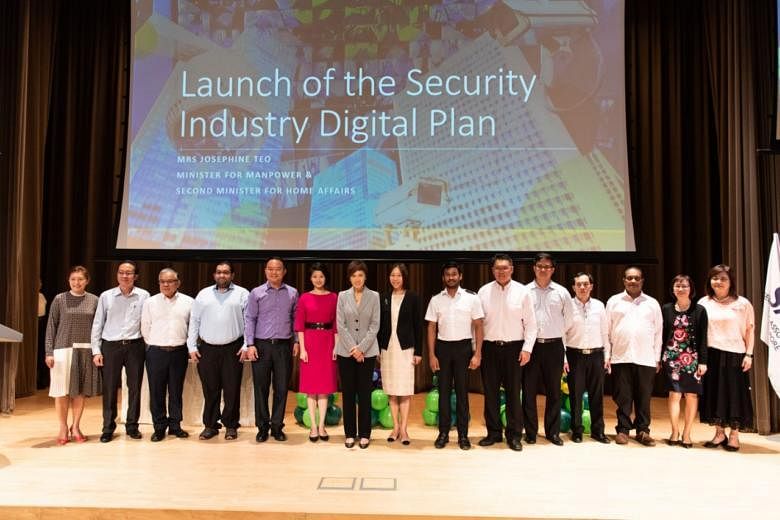SINGAPORE - By 2025, most security agencies should aim to adopt basic technology solutions such as automated visitor management and closed-circuit television cameras that can analyse the videos they record.
Currently, only 30 per cent of the 240 security firms here have leveraged such technology, said Second Minister for Home Affairs Josephine Teo on Wednesday (July 18).
"As far as we can tell, adoption of these basic building blocks is still very low. Many agencies don't use any of the technologies... In other words, we are still very far from a technology-enabled future of the industry," she said.
Mrs Teo was speaking at the Security Officers' Day Awards Ceremony, where she launched the Security Industry Digital Plan that aims to get smaller security agencies on board to adopt technology.
She said the Government and stakeholders are hoping that through initiatives under the industry digital plan, the number of security agencies that adopt technology would double by 2020, and that come 2025, these technologies should be a "norm and not the exception".
Mrs Teo stressed the need to transform the industry's manpower-intensive business model, as factors such as the removal of overtime exemption by 2021 would increasingly add pressure on manpower.
"Among other things, there will be a decisive shift to use technology. Our security officers will deliver better security, but with a leaner team," she said at the event, which was held at NTUC Centre in Marina Boulevard.
"They will use more sophisticated 'hardware', but the key will be the 'software' of people and processes, which ensure technology is used in a meaningful way."
The Security Industry Digital Plan, developed by the Infocomm Media Development Authority and the Ministry of Home Affairs, in consultation with stakeholders, provides a step-by-step guide on technology solutions for companies to adopt at each stage of growth.
The first of three stages in the road map lists basic technology as building blocks that every security agency needs to stay competitive in the future, through automating routine and manpower-intensive tasks.
The basic technology includes visitor management systems, the use of customised smartphones to report incidents and track officers for better safety and situational awareness, and surveillance cameras with analytics.
The next two stages of the road map identify technology for more advanced security agencies, such as the use of robotics or cluster guarding, where a group of guards manage security for multiple buildings.
Said Mrs Teo: "To help with the upfront cost of adopting technology, we will also provide funding support to local small and medium enterprise (SME) security agencies."
At least $7 million will be set aside by Enterprise Singapore over the next few years to help security agencies kick-start the adoption of pre-approved digital solutions identified in the digital road map through the Productivity Solutions Grant.
The grant will support 50 per cent of qualifying costs, capped at $30,000 per security agency per year.
Mrs Teo said the list of pre-approved digital solutions would make it easier for security agencies to adopt the technologies that are "proven, market-tested and cost-effective".
"This reduces effort needed by SME security agencies to find their own solutions, and gives them peace of mind that the vendor is reliable," she said.
A technical reference for video analytics systems is also in the works by two industry-led working groups.
It is led by the Security Association of Singapore and Security Systems Association of Singapore, and will help to benchmark quality and reliability of video analytics systems for buyers and service providers.
"As we invest in more technology, performance and inter-operability standards will become particularly important. This is especially so for solutions like video analytics where there are many vendors with different specifications," said Mrs Teo.
Video analytics systems have been identified as a key solution that can help detect incidents and monitor multiple areas simultaneously. It can also reduce manpower intensive patrols and facilitate collaboration among security agencies. There is currently no international standard to evaluate video analytics systems.
The technical reference, which will be ready by the end of 2019, will provide requirements and specifications for the selection, installation, operation, maintenance and data inter-operability of video analytics systems.


